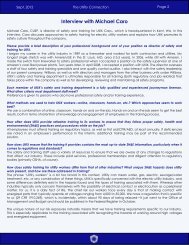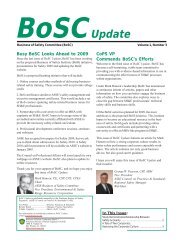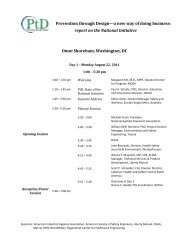Ansi/asse z590.3-2011 - American Society of Safety Engineers
Ansi/asse z590.3-2011 - American Society of Safety Engineers
Ansi/asse z590.3-2011 - American Society of Safety Engineers
You also want an ePaper? Increase the reach of your titles
YUMPU automatically turns print PDFs into web optimized ePapers that Google loves.
3.7 Hazard Analysis. A process that commences with the identification <strong>of</strong> a hazard or<br />
hazards and proceeds into an estimate <strong>of</strong> the severity <strong>of</strong> harm or damage that could result if the<br />
potential <strong>of</strong> an incident or exposure occurs.<br />
3.8 Hierarchy <strong>of</strong> Controls. A systematic approach to avoiding, eliminating, controlling,<br />
and reducing risks, considering steps in a ranked and sequential order, beginning with avoidance,<br />
elimination, and substitution. Residual risks are controlled using engineering controls, warning<br />
systems, administrative controls, and personal protective equipment.<br />
3.9 Lifecycle. The phases <strong>of</strong> design, construction, operation, maintenance, and disposal for<br />
a facility, equipment, process, and material.<br />
3.10 Occupational Exposure Limit (OEL). The generic term applied to the amount <strong>of</strong> a<br />
chemical, physical, or biological agent to which a worker can be exposed for a period <strong>of</strong> time,<br />
below which it is believed health is not impaired. OELs for air contaminants and noise are<br />
expressed as full shift time-weighted average values (8, 10, 12 hours, etc.), short-term exposure<br />
limits (STELs), Excursion Limits and Ceiling limits (C). Biological OELs are available for some<br />
chemicals and are employed where the main route <strong>of</strong> exposure is skin absorption and/ or<br />
inadvertent ingestion. OELs for ionizing radiation are generally expressed as a cumulative dose.<br />
Specific terms and values are established by 1) governmental regulatory agencies, 2)<br />
authoritative organizations, 3) internal company limits, or 4) working limits or guidelines.<br />
3.11 Organization. A public or private company, corporation, firm, enterprise, government<br />
agency, non-governmental organizations, authority, or institution, or part or combination there<strong>of</strong>,<br />
whether incorporated or not, that has its own management functions. This can consist <strong>of</strong> one or<br />
many sites or facilities.<br />
3.12 Prevention through Design. Addressing occupational safety and health needs in the<br />
design and redesign process to prevent or minimize the work-related hazards and risks associated<br />
with the construction, manufacture, use, maintenance, retr<strong>of</strong>itting, and disposal <strong>of</strong> facilities,<br />
processes, materials, and equipment.<br />
3.13 Probability. An estimate <strong>of</strong> the likelihood <strong>of</strong> an incident or exposure occurring that<br />
could result in harm or damage for a selected unit <strong>of</strong> time, events, population, items or activity<br />
being considered.<br />
3.14 Process. A series <strong>of</strong> progressive and interrelated steps by which an end is attained;<br />
continuous action, operation, or a series <strong>of</strong> changes taking place in a definite manner; the action<br />
<strong>of</strong> going forward.<br />
3.15 Reasonably Foreseeable Misuse. The predictable use <strong>of</strong> facilities, equipment, or<br />
materials in a way not intended in the original design.<br />
3.16 Redesign. A design activity that includes all retr<strong>of</strong>itting and altering activities affecting<br />
existing facilities, equipment, technologies, materials, and processes, and the work methods.<br />
6










![Are You Trapped by Your Life as a [Compatibility Mode]](https://img.yumpu.com/5083828/1/190x146/are-you-trapped-by-your-life-as-a-compatibility-mode.jpg?quality=85)


